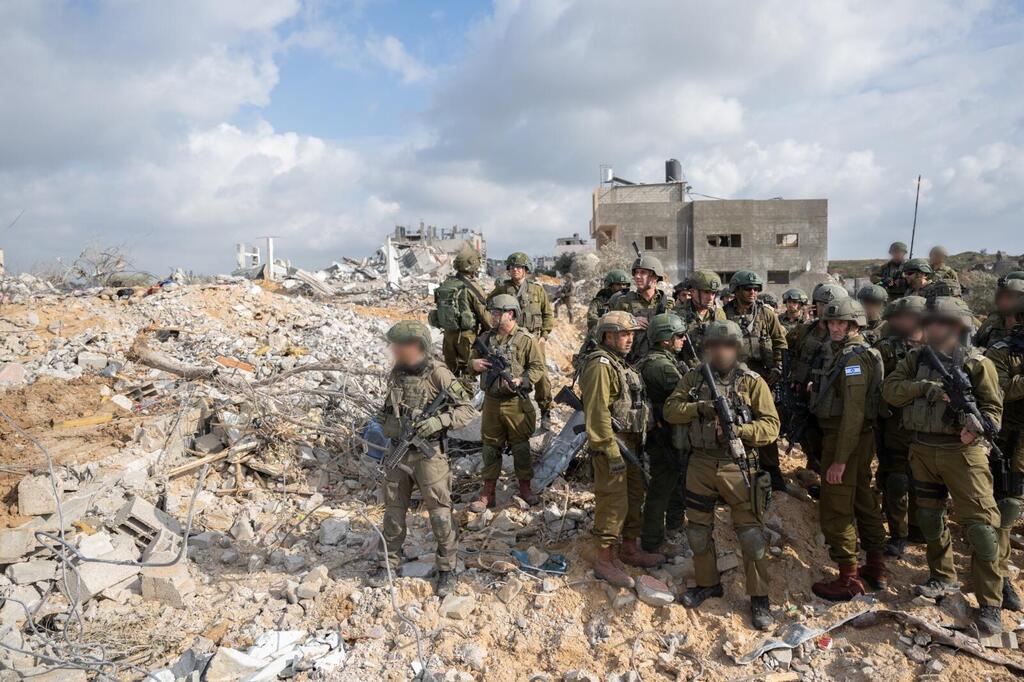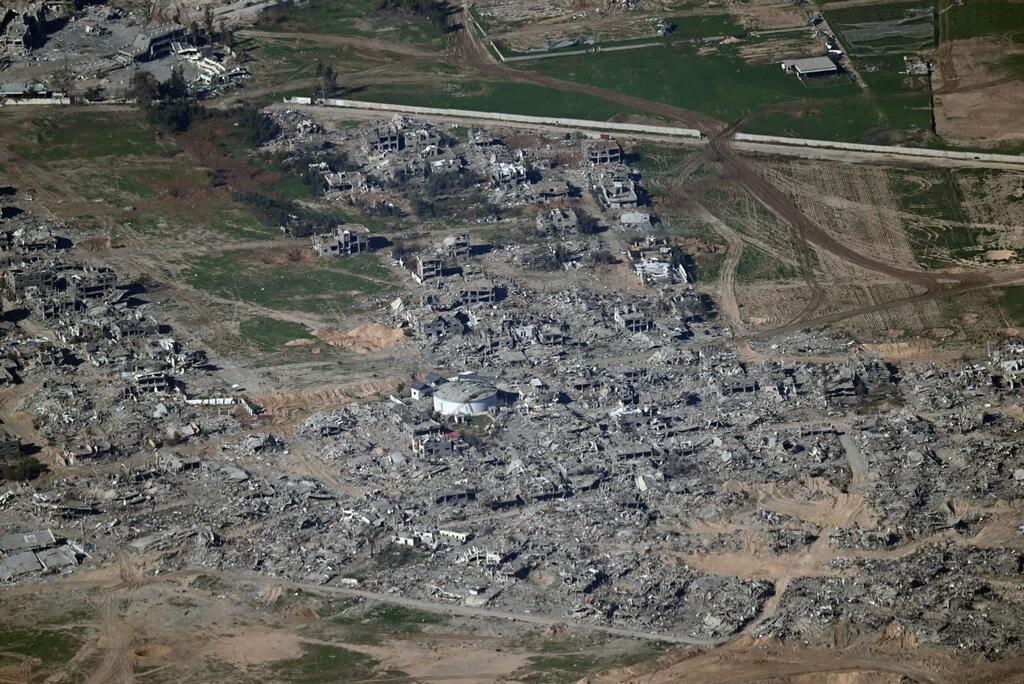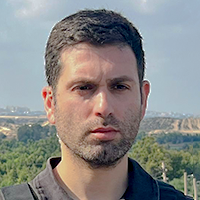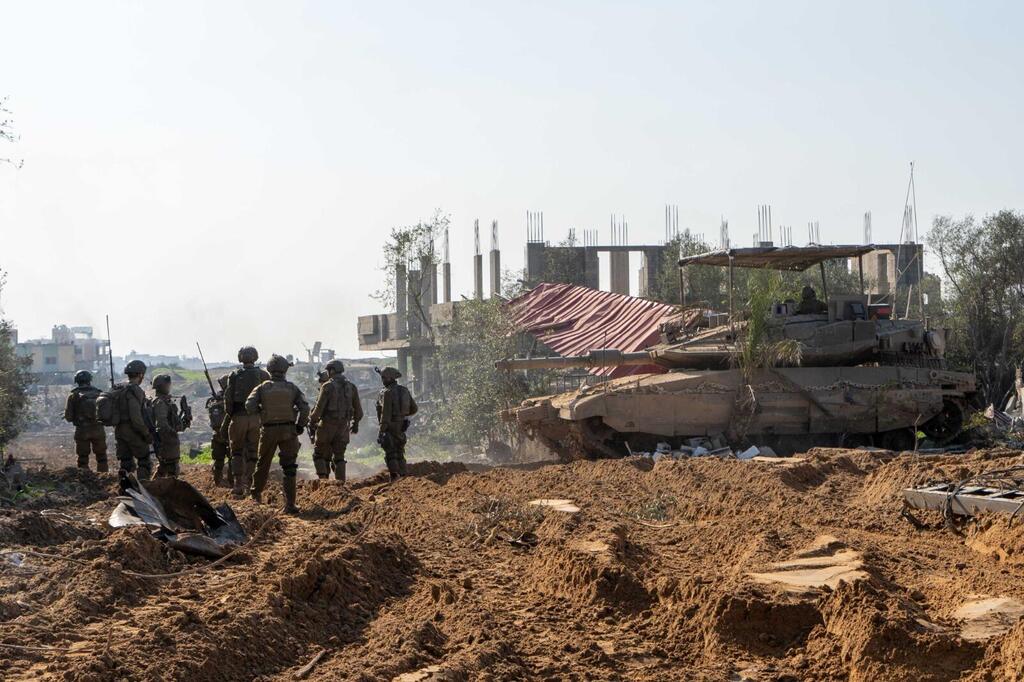The operation in which 21 reserve soldiers were killed on Monday afternoon reveals a fraction of one of the most significant and sensitive operations of the Southern Command in recent weeks – demolishing thousands of acres of Gazan land to remain under Israeli control after the war.
Read more:
The military, with the approval of the political echelon, decided to seize a sizeable portion of the Gaza Strip even after the end of the war to allow the residents of the Western Negev to return to their homes with relative security.
3 View gallery


IDF forces at the scene of the building collapse disaster in Gaza
(Photo: IDF Spokesperson's Unit)
The move includes the demolition of Palestinian buildings that served as observation and firing positions on border-adjacent communities such as Netiv HaAsara, Nir Oz, Kfar Aza, Kerem Shalom and the western neighborhoods of Sderot.
In some cases, entire Palestinian neighborhoods have already been demolished, such as in Beit Hanoun, Jabaliya and Shijaiyah, a process that the IDF is carrying out relatively quickly and on a daily basis, under the command of the Gaza Division – which is also expected to undergo a significant restructuring.
On the day of the disaster, the reserve force that was hit planned to clear about 10 Gazan buildings within a range of less than a mile from the border, near Kibbutz Kissufim. As part of these operations, engineering forces are also clearing orchards, greenhouses and groves, in a way that completely changes the skyline of the Israeli side of the border from what was familiar to any visitor to the area or driver on Route 232 until October 6 of last year
"I want residents of Kfar Aza who return home to open their western window and no longer see the houses of Shijaiyah in front of them. That's why we're here," an officer responsible for such operations told Ynet last month.
So far, thousands of explosives have been used to demolish such buildings, others were destroyed using engineering equipment like D9 bulldozers and excavators, and almost none of them were bombed from the air. In one experimental case, a cannon was also used to directly demolish homes near the border on the hill where the Shijaiyah neighborhood lies.
3 View gallery


The border-adjacent Shijaiyah neighborhood largely demolished
(Photo: IDF Spokesperson's Unit)
The rationale behind the ground-based destruction strategy is rooted in operational efficiency. There were and still are thousands of targets for demolition across the Gaza Strip, especially in Khan Younis, and using air-dropped bombs to destroy homes in creating the new buffer zone would require prudent use of ammunition. So far, the Israeli Air Force has launched tens of thousands of bombs and missiles in the war, and needs to manage its ammunition for a potential flare-up with Hezbollah on the northern front.
Furthermore, when it comes to demolishing structures, particularly multi-story buildings, ground-engineering methods have proven to be more effective and efficient compared to aerial attacks.
When battalion or company commanders report finding weapons in every home of a Gazan neighborhood they targeted, their statements are based on factual observations, not exaggerations or clichés. The extent of homes in the Gaza Strip used by Hamas for combat operations is substantial, necessitating targeted operations, especially considering the vast network of tunnels requiring demolition.
The Combat Engineering Corps has recently enhanced its capabilities by acquiring tens of thousands of demolition charges and other innovative types of explosive materials. These acquisitions are part of a strategy to maximize damage while minimizing the use of materials, and some have already been deployed in operations.
The operation to reshape the border will continue regardless of the disaster in the Kissufim sector. On Tuesday, border-adjacent houses at the disaster site were demolished through controlled engineering explosions. The redesigned border strip, extending into Gazan territory, is expected to incorporate new military installations, including both permanent and mobile positions, as well as the construction of military roads and fortified observation posts, representing a shift in operational defense strategy.
Furthermore, there's a possibility that the Central Brigade, formerly a part of the Gaza Division before it was restructured into only southern and northern brigades – which have themselves been downsized by a battalion and a half in recent years – might be reinstated to man the new buffer zone.
International concern also arises from the anticipated expropriation of Palestinian land in the Gaza Strip – a strip about a mile wide along the 40 miles of the border with Israel. Before the war, this area was comprised of agricultural fields that provided livelihoods for many Palestinians. Most of Gaza is narrow, not exceeding 5 and half miles in the northern part of the Strip and 9 miles in the south, up to the seashore. The encroachment could significantly impact Gazan agriculture in the post-war period.
The United States objects
On Monday, U.S. Secretary of State Antony Blinken said that Washington opposes any "permanent change" to Gaza's territory, although he left open the possibility of "temporary agreements" within the context of resolving the conflict.
White House National Security Council spokesperson John Kirby reiterated the U.S. opposition to the creation of the buffer zone, saying, "We do not want to see a reduction in Gazan territory under any circumstances. We will not support it."
The New York Times quoted UN Special Rapporteur on the Right to Housing Balakrishnan Rajagopal, who argued that the systematic demolition of homes along the border could be considered a war crime, as they do not pose an immediate risk to Israel. "There's nothing in the Geneva Conventions that allows what Israel is doing at the border," he said.
Large-scale operation in Khan Younis
Meanwhile, the IDF successfully completed this week a large-scale operation as part of the 98th Division's mission to dismantle Hamas' Khan Younis Brigade. The army announced the strategic capture of this major city in the Gaza Strip, a central hub in the Palestinian enclave’s southern region.
IDF forces operating in Khan Younis
(Video: IDF Spokesperson's Unit)
The operation presumably focused on key urban areas such as the refugee camp, the kasbah and the western municipal square, which are believed to be hiding spots for senior Hamas leaders.
However, the IDF hasn't ruled out the possibility that some may have fled to nearby Rafah or to Deir al-Balah, a coastal city in central Gaza, which the IDF has not entered so far.
Unlike the initial ground operations led by the 36th and 162nd Divisions in northern Gaza, the fighting in Khan Younis has proven more challenging, with fewer terrorists fleeing the combat areas.
The city's western battalions, yet to be dismantled by the IDF, prepared for the arrival of Israeli forces, setting up numerous explosive traps and organizing combined ambushes, particularly leveraging advanced weaponry that was not previously available to Hamas forces in Gaza City and its suburbs.
Additionally, Khan Younis has a relatively large presence of Gazan civilians who have not been evacuated from significant parts of the city, due to the exhaustion of "displacement routes" and the extreme overcrowding in areas like Rafah or al-Mawasi, complicating the operation.
Recent reports show tanks advancing alongside densely populated streets in the city's west, in an operation spearheaded by special forces units like Maglan and Egoz, specialized in precise, surgical combat in refugee camps.
The military indicated that the fighting in western Khan Younis is expected to persist for several days, although this timeframe might be underestimated. This assessment mirrors earlier forecasts for the battles in northern Gaza Strip's Hamas strongholds, which spanned one to two weeks per neighborhood and ground target.
In Khan Younis, the home brigade of Yahya Sinwar and Mohammed Deif has not exhibited any inclination toward capitulation or retreat. This resistance has led the IDF to intensify its efforts in what is considered a pivotal stage of the ground operation in this conflict.






